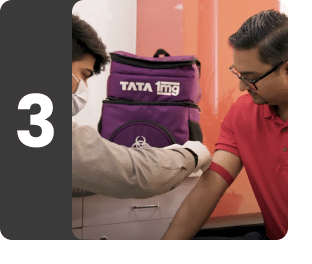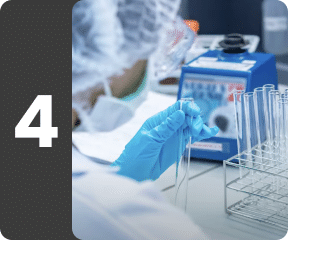Thalassemia Profile near me in Dehradun
Understanding Thalassemia Profile in Dehradun
What is Thalassemia Profile in Dehradun?
What does Thalassemia Profile measure?
Contains 26 tests
Hemoglobin HPLC/ Electrophoresis
Hemoglobin (Hb) Electrophoresis by HPLC test measures and identifies different types of hemoglobin in the blood. A human body contains various types of hemoglobin in their blood. With age, the percentage of hemoglobin present in the body changes. Hemoglobin is the protein which is present inside the red blood cells. Its function is to transport oxygen to the tissues and organs of the body.
When there is a change in DNA sequence commonly called a mutation, the production of hemoglobin gets affected. These type of changes cause abnormality in hemoglobin and the normal working of healthy hemoglobin gets defected. This will result in a decreased amount of required oxygen transported to tissues and organs.
The different types of hemoglobin included in this test are:
Hemoglobin A - Adult hemoglobin
Hemoglobin F
Hemoglobin F is found in growing fetuses and newborns. It is soon replaced with hemoglobin A after birth. Hemoglobin A is found in children and adults. It is the most common type of hemoglobin. Hemoglobin C, D, E, M, and S are rare types of abnormal hemoglobin that occur due to genetic mutations.
Know more about Hemoglobin HPLC/ Electrophoresis

Complete Blood Count
Blood Stag is composed of blood cells suspended in blood plasma (yellowish-colored liquid). The blood cells include red blood cells (also called RBCs or erythrocytes), white blood cells (also called WBCs or leukocytes), and platelets (also called thrombocytes).
Red blood cells (RBCs) are the most abundant blood cells. RBCs contain hemoglobin which helps in the transportation of oxygen to the tissues. RBC count is the measurement of the number of RBCs in a given volume of blood.
Packed Cell Volume (PCV) or Hematocrit (Hct) is the measurement of the blood volume occupied by RBCs. It is expressed in percentage.
White blood cells (WBCs) are key components of the immune system and thus protect the body from various infections and cancers. Total Leucocyte count (TLC) is the measurement of the total number of leukocytes (WBCs) in a given volume of blood.
There are five types of WBCs:
-
Neutrophils
-
Basophils
-
Eosinophils
-
Lymphocytes
-
Monocytes
Differential Leucocyte Count (DLC) determines the percentage of different types of WBCs.
Neutrophils, Basophils, and Eosinophils are called Granulocytes because of the presence of granules inside these cells.
Absolute count of different types of WBCs is the measurement of their absolute numbers in the given volume of blood.
Platelet count - Platelets (also called thrombocytes) are disc-shaped cell fragments without a nucleus that help in blood clotting. Platelet count is the measurement of the number of platelets in a given volume of blood.
Mean Platelet Volume (MPV) is a measurement of the average size of platelets.
PDW or platelet distribution width refers to the variation of platelet size distribution
Hemoglobin (Hb) - Hemoglobin (Hb) is a protein found in red blood cells (RBCs) that carries oxygen from the lungs to the body tissues, exchanges the oxygen for carbon dioxide, and then carries the carbon dioxide back to the lungs where it is exchanged for oxygen.
Mean Corpuscular Volume (MCV) is the average volume of a red blood cell.
Mean Corpuscular Hemoglobin (MCH) is the average amount of hemoglobin in the average red blood cell.
Mean Corpuscular Hemoglobin Concentration (MCHC) is the average concentration of hemoglobin in a given volume of red cells.
Red Cell Distribution Width Coefficient of variation (RDW CV)is a measurement of the variability of the red blood distribution curve and their mean size.
Know more about Complete Blood Count
PDW
RDW CV
Absolute Lymphocyte Countx
Absolute Neutrophil Count
It gives us a measure of one of the components of the white blood cells , called Neutrophils. While all white blood cells help your body fight infections, neutrophils are important for fighting against bacterial infection.
Differential leucocyte Count
- Differential Neutrophil Count
- Differential Lymphocyte Count
- Differential Monocyte Count
- Differential Eosinophil Count
- Differential Basophil Count
Blood is made up of different types of cells which are suspended in a fluid called plasma. These include erythrocytes or red blood cells, leukocytes or white blood cells, and platelets. Blood cells are produced by the hematopoietic cells in bone marrow and are then released into circulation. RBCs carry oxygen to the tissues, platelets help in blood clotting at a site of injury, and leukocytes form an integral part of the immune system of the body.
WBCs are of five types, each having a different function and present in different numbers:
1. Neutrophils: Under normal conditions, the number of neutrophils present is higher than any other type of WBCs.. They provide protection against pathogens, mostly bacteria and sometimes fungi. Neutrophils engulf the pathogens completely and digest them (the process is called phagocytosis). They are usually associated with acute or short-term infections.
2. Eosinophils: Eosinophils are WBCs that are primarily responsible to fight parasitic infections. They are also involved in allergic reactions and regulation of the extent of immune response.
3. Basophils: Basophils are WBCs which are present in the lowest numbers in circulation. They are considered to play an important role in allergic response.
[Neutrophils, eosinophils, and basophils are together classified as granulocytes. Granulocytes are the WBCs which contain granules present in their cytoplasm. These granules secrete chemicals during immune response.]
4. Monocytes: Monocytes are WBCs which are also involved in protection against infectious pathogens by phagocytosis like neutrophils. However, monocytes are more commonly associated with chronic or long-term infections.
5. Lymphocytes: These are specialized WBCs which are responsible for recognizing and neutralizing foreign (non-self) cells and cancer cells in the body. Lymphocytes are of three types, all of which are differentiated from a common type of lymphocyte progenitor cell:
· T cells or T lymphocytes are produced in the bone marrow and mature in the thymus gland. They are responsible for differentiating between self and non-self cells of the body. T cells are also responsible for the initiation and extent of immune response, and targeted destruction of cancer cells and virus.
· B cells or B lymphocytes are control acquired immunity by producing antibodies against antigens found on foreign cells and pathogens like bacteria and viruses.
· Natural killer cells or NK cells destroy all foreign cells tagged by antibodies, cancer cells and virus-infected cells by phagocytosis.
Depending on various factors like age, gender, health condition, environmental factors, etc., varying amounts of different types of WBCs circulate in the blood. The bone marrow increases production of WBCs in response to an infection or inflammation anywhere in the body, which are then called to the site by a series of chemical signals, where they work to treat the condition. Depending on the condition, the count of one or more types of WBCs remains high in the blood. Once the condition subsides, WBC production by the bone marrow decreases and their count in circulation falls back to normal levels. Elevated amount of one or more types of leukocytes for a long time may be an indication of a chronic condition that is not resolving naturally and might need urgent attention.
Apart from an infection or inflammation, WBC count in blood can also be affected by other conditions like disorders of the immune system, autoimmune conditions, cancer, etc. One or more types of WBC count may be higher or lower than normal in these cases.
Differential Leukocyte Count Test serves as an indication of a condition affecting the body. Further tests are performed to confirm a particular condition and direct treatment.
This further contains
Red Blood Cell Count
Hemoglobin
The hemoglobin test measures the amount of hemoglobin in the blood.
Hemoglobin (Hb) is a protein found in red blood cells (RBCs) that carries oxygen from the lungs to the body tissues, and to exchange the oxygen for carbon dioxide. Hemoglobin then carries the carbon dioxide back to the lungs and where it is exchanged for oxygen. Iron is an essential part of hemoglobin. Most blood cells, including red blood cells, are produced regularly in your bone marrow (present within the cavities of many of large bones). To produce hemoglobin and red blood cells, your body needs iron, vitamin B12, folate and other nutrients from the foods you eat.
A decrease in hemoglobin concentration in blood results in anemia. Anemia is a blood disorder characterized by a decrease in the total amount of red blood cells (RBCs) or hemoglobin in the blood or a lowered ability of the blood to carry oxygen to body organs and tissues. Anemia is the most common blood disorder, affecting about a third of the global population and can cause symptoms like tiredness (fatigue), weakness, shortness of breath etc.
The hemoglobin test is usually performed as a part of complete blood count (CBC) test.
Platelet Count
The platelets will adhere to the injury site
The platelets will accumulate at the injury site
The platelets will release chemical compounds which stimulate gathering of other platelets
The platelet count measures the number of platelets present in the blood. Platelets are also known as thrombocytes which are tiny fragments of cells. These are formed from large cells which are found in the bone marrow known as megakaryocytes. After the platelets are formed, they are released into the blood circulation.
Whenever there is an injury to a tissue or blood vessel, bleeding starts. At this point, platelets help in stopping the bleeding in three ways:
With these steps, a loose platelet connection forms at the site of injury. This process is known as primary hemostasis. The activated platelets start to support the coagulation cascade which involves a series of steps that includes the sequential activation of clotting factors. This process is known as secondary hemostasis which results in the formation of fibrin strands that knit through the loose platelet connection to form a fibrin net. After that, the connection is compressed to form a stable clot so that it remains in place until the injury heals. Once the injury is healed, other factors come into play and break it down so that it gets removed.
In case the platelets are not sufficient in number or are not functioning properly, a stable clot might not form. These unstable clots can result in an increased risk of excessive bleeding.
Total Leucocyte Count
Blood is made up of different types of cells suspended in a fluid called plasma. These include erythrocytes or red blood cells, leukocytes or white blood cells, and platelets. Blood cells are produced by the hematopoietic cells in bone marrow and are then released into circulation. RBCs carry oxygen to the tissues, platelets help in blood clotting at a site of injury, and leukocytes form a part of the immune system of the body. WBCs are of five primary types: neutrophils, basophils, eosinophils, monocytes, and lymphocytes. Lymphocytes are further of three types: B-Lymphocytes, T-Lymphocytes, and natural killer (NK) cells. Neutrophils, basophils, eosinophils are collectively called granulocytes since they contain granules in cytoplasm.
Depending on various factors like age, gender, health condition, environmental factors, etc., varying amounts of different types of WBCs circulate in the blood. The bone marrow increases the production of WBCs in response to an infection or inflammation anywhere in the body. These WBCs are called to the site by a series of chemical signals, where they work to treat the condition. During this time, the total leukocyte count remains high in blood. Once the infection or inflammation subsides, WBC production by bone marrow decreases and WBC count in circulation falls back to normal levels. A continuously elevated WBC count may thus be an indication of a chronic condition that is not resolving naturally and might need urgent attention.
Apart from an infection or inflammation, WBC count in blood can also be affected by other conditions like disorders of the immune system, autoimmune conditions, cancer, etc. WBC count may be higher or lower than normal in these cases.
WBC count test serves as an indication of a condition affecting the body. Further tests are performed to confirm a particular condition and direct treatment.
Absolute Basophil Count
Absolute Monocyte Count
Absolute Eosinophil Count
The absolute eosinophil count measures the number of eosinophils present in the blood. Eosinophils, a type of white blood cells, helps in fighting the disease. These come into action for are said to be linked with certain infections and allergic diseases. The eosinophils are produced and mature in the bone marrow. They usually take about 8 days to mature and then are moved to blood vessels.
The eosinophils have varied functions which include the physiological role in organ formation such as the development of post-gestational mammary gland. Other functions include its movement to the areas of inflammation, trapping substances, killing cells, bactericidal and anti-parasitic activity. It also helps the treatment of immediate allergic reactions and modulation of inflammatory responses.
Hematocrit
Human blood is made up of erythrocytes or red blood cells, leukocytes or white blood cells, and platelets suspended in a fluid called plasma. Each of the component of blood performs a specific function. The packed cell volume or hematocrit is a ratio of the volume occupied by the RBCs to the total volume occupied by all the blood components or whole blood.
The RBCs transport inhaled oxygen from the lungs to all the cells of the body, and also a small amount of carbon dioxide from the cells to the lungs to be exhaled. The majority of carbon dioxide is transported in solution in plasma as bicarbonate ions. They contain a protein called hemoglobin which binds to oxygen for transport.
RBCs are produced in the erythropoietic cells of the bone marrow in response to the hormone Erythropoietin secreted by the kidneys when oxygen saturation of blood is detected to be low (hypoxia). The average lifespan of RBCs in circulation is 120 days. Hence, the bone marrows continuously produce RBCs to maintain a steady concentration in blood. The Packed Cell Volume Test depends on the count as well as the average size of the RBCs (Mean Corpuscular Volume or MCV). Higher than normal amount of RBCs produced by the bone marrow can cause the hematocrit to increase, leading to increased blood density and slow blood flow. Lower than normal hematocrit can be caused by low production of RBCs, reduced lifespan of RBC in circulation, or excessive bleeding, leading to reduced amount of oxygen reaching the cells.
Mean Corpuscular Volume
Mean Corpuscular Hemoglobin
Mean Corpuscular Hemoglobin Concentration
Mean Platelet Volume
GT New Test 2 added organ and changed name sample 45
utt

Total Iron Binding Capacity
Iron is an essential micronutrient that is required by the body in trace amounts. Iron plays an essential role in a number of body activities. The most important role of iron is that it regulates the formation and functioning of red blood cells or RBCs. Iron is an integral part of a protein called hemoglobin present in the RBCs. RBCs transport oxygen from the lungs to other body tissues.
Iron is not produced by the body and its only source is diet. Only a minute quantity of iron is required by the body. Most of the iron obtained from the food is found in hemoglobin present inside the RBCs. Excess iron absorbed from food is stored as ferritin, and a small amount is present in myoglobin and enzymes. Ferritin is stored in the liver, spleen, bone marrow, and skeletal muscles. When the iron level in the blood drops, it is recovered from these stored iron reserves.
The protein transferrin is produced by the liver and transports iron to different parts of the body for utilization or storage. Low levels of transferrin can impair the transport of iron for utilization or storage and may give rise to symptoms of iron deficiency or overdose. Transferrin is a negative acute phase reactant which means that its level decreases in case of inflammation in the body. It is the primary iron-transporting protein in the body and most of the free iron remains bound to it.
The following tests are performed apart from the Total Iron Binding Capacity Test to measure the iron levels of the body and results are interpreted accordingly:
· Serum Iron Test measures the levels of iron present in the blood.
· Transferrin Test measures the levels of transferrin present in blood both bound and unbound with iron.
· Unsaturated Iron Binding Capacity (UIBC) Test measures the transferrin reserve of the body, or the amount of transferrin not saturated with iron.
· Transferrin Saturation Test is performed to determine the amount of transferrin that is saturated with iron. In normal conditions, approximately one-third of transferrin is bound to and saturated with iron.
· Ferritin Test measures the amount of the protein ferritin in blood. Ferritin is the primary iron storage protein of the body.
Know more about Total Iron Binding Capacity
Iron Serum
Unsaturated Iron Binding Capacity
Book a Thalassemia Profile test at home near me





Other tests









